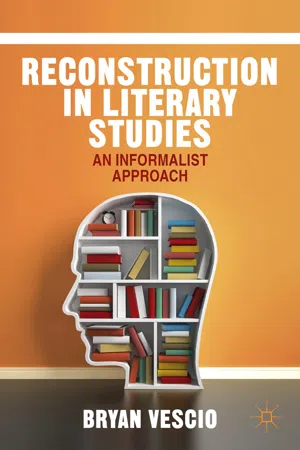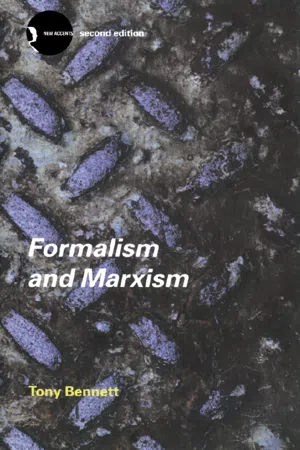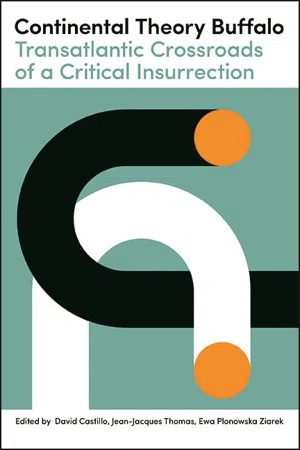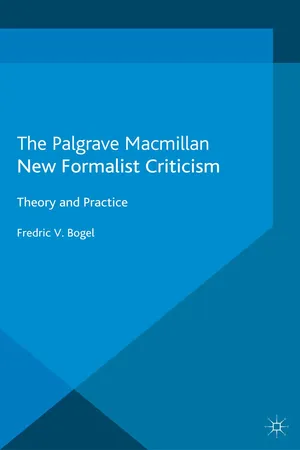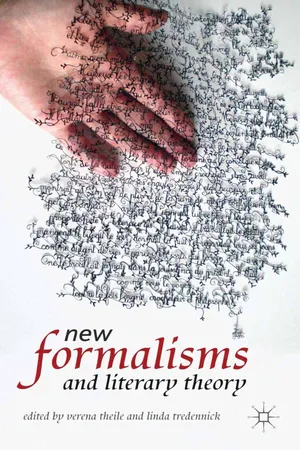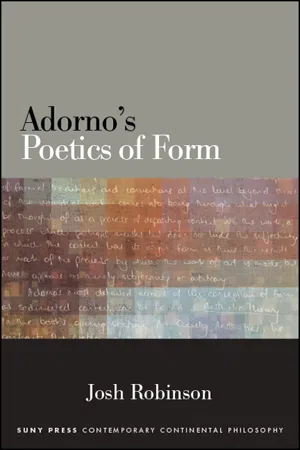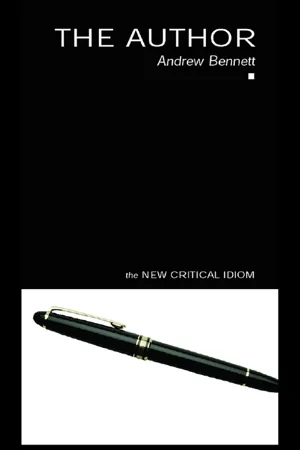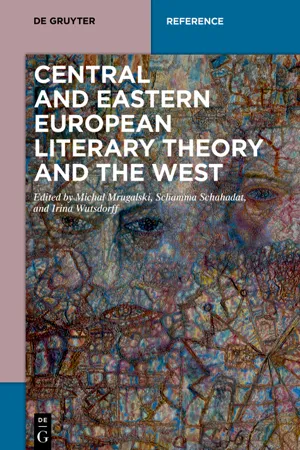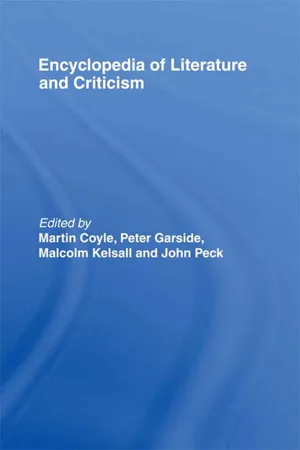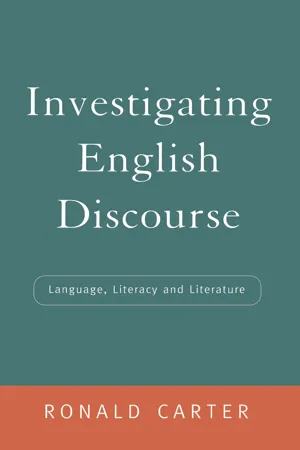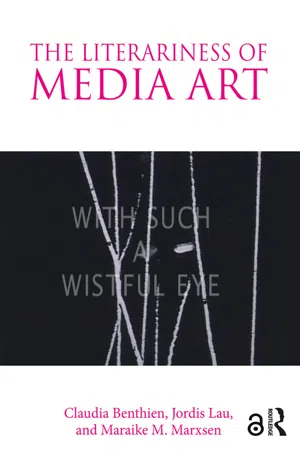Literature
Formalism Literary Theory
Formalism literary theory emphasizes the intrinsic structure and form of a literary work, focusing on elements such as language, style, and literary devices rather than external factors like historical or biographical context. It seeks to analyze the text as a self-contained entity, highlighting the significance of form in conveying meaning and aesthetic value.
Written by Perlego with AI-assistance
Related key terms
12 Key excerpts on "Formalism Literary Theory"
- eBook - ePub
Reconstruction in Literary Studies
An Informalist Approach
- B. Vescio(Author)
- 2014(Publication Date)
- Palgrave Macmillan(Publisher)
Introduction Formalism, Antiformalism, and InformalismWhen a discipline is no longer sure what it’s supposed to be doing, it starts to theorize. Judging by its history of proliferating theories, the institution of academic literary studies has never been too sure of just what it does. Maybe the closest it came was in the early 1960s, when almost everyone seemed to be satisfied with the formalist justifications of the New Critics. But the wave of theory that swept over the discipline later that decade demonstrated that what formalist critics claimed to be doing is impossible and that what they were actually doing was something very different, and in some respects insidious. The process of undermining formalist conceptions of literature and revising the practices they served to justify is now more or less complete. Curiously, though, contemporary literary theory has done little to replace those formalist conceptions with more coherent ones. The consequences of this fact are worth exploring.Many literary scholars today are eager to trumpet the “end of theory” as if the discipline had once and for all resolved the central question that, by definition, drives literary theory: that of the nature or function of “literature.”1 To be sure, academic literary critics have reached some tacit understandings about what sorts of practices are acceptable within their discipline, but conspicuously absent from these understandings is a shared sense of what defines the category of the “literary.” A cursory glance at a few prominent journals of literary scholarship confirms that one of the profession’s most commonly held assumptions is that race, class, gender, and sexuality are the most important contexts in which to discuss literary texts. But which texts are those? Theorists of race, class, gender, and sexuality certainly offer important correctives to formalist theory and practice, but they fail to provide a viable alternative to the formalist conception of literature. They merely change the subject from literature to culture, leaving wide open the question of what literature is.2 - eBook - ePub
- Tony Bennett(Author)
- 2004(Publication Date)
- Routledge(Publisher)
As we have seen, the Formalists argued that this difference consisted in the tendency of literary works to defamiliarize experience by working on and transforming the adjacent ideological and cultural forms within which reality is dominantly experienced. The prime task for literary criticism became that of analysing the constructional devices whereby this effect of defamiliarization was achieved. The object of the Formalists’ research was thus not the concrete object of literary texts themselves but the abstract object of the differential relation between literary texts and non-literary texts, a problematic (in the sense defined above) that was entirely the product of their own theoretical procedures.The paradox at the heart of the Formalists’ endeavour was that the more they pursued this object, the more it receded from view.For they were forced, by the logic of their own researches, to call into question the assumption that there existed a fixed and stable body of texts which might be regarded as ‘literature’. In Formalist parlance, the question as to whether a given text should be described as literary’ could be resolved only with reference to the function it fulfilled. And that, so it turned out, obliged the Formalists to take account of considerations that were inescapably and radically historical.THE SYSTEM AND ITS ELEMENTS: FORM AND FUNCTION
It is often argued that the Formalists viewed literary texts in a vacuum, regarding their ‘literariness’—their ability to ‘defamiliarize’—as an attribute of their purely formal, intrinsic properties. To gainsay this, one must keep in mind the inherently relational nature of the concept of defamiliarization. To study the phenomenon of literariness is to study the relationship between the series of texts designated as ‘literary’ and those ‘non-literary’ (but linguistic) cultural forms which literary texts transform by ‘making strange’ the terms of seeing proposed in them. Whether or not a given text can be said to embody the attribute of defamiliarization thus depends not on its intrinsic properties in isolation but on the relationship which those properties establish with other cultural and ideological forms. - eBook - ePub
SUNY series, Humanities to the Rescue
Transatlantic Crossroads of a Critical Insurrection
- David R. Castillo, Jean-Jacques Thomas, Ewa Plonowska Ziarek, David R. Castillo, Jean-Jacques Thomas, Ewa P?onowska Ziarek, Ewa P?onowska Ziarek, Ewa P?onowska Ziarek, Ewa P?onowska Ziarek, Ewa P?onowska Ziarek, Ewa P?onowska Ziarek, Ewa P?onowska Ziarek, Ewa P?onowska Ziarek, Ewa Plonowska Ziarek(Authors)
- 2021(Publication Date)
- SUNY Press(Publisher)
Located within different intellectual arenas, these approaches respond to different aspects of the complex and contradictory legacy of structuralist and poststructuralist theory. Defined differently in France and in the US, that body of theory had grounded (via structuralism) earlier formalist approaches to the literary text, but had also inspired (especially via Foucault) the new-historicist/cultural-studies turn in literary scholarship. 3 Responding to these theoretical traditions, contemporary formalisms develop a capacious understanding of the concepts of form or style, one that extends beyond the literary work to social life—and indeed to all life, in the case of Macé’s “stylistics of existence.” From this perspective, if the literary work contains form—since forms and styles are everywhere—it is not set apart as a formal shaping of language - eBook - ePub
New Formalist Criticism
Theory and Practice
- F. Bogel(Author)
- 2013(Publication Date)
- Palgrave Macmillan(Publisher)
Like the term “symbolic” in Cassirer’s discourse, then, the term “literary” in the language of formalism seems to entail certain assumptions. These include the primacy of the linguistic identity of the text; the text’s inability to interpret itself (with the consequent need for critical analysis); and its performance of a creative or constructivist rather than a mimetic relation to reality (producing and positing a world of its own, to adapt Cassirer’s formulation). In part because of its freedom from mimesis or referentiality, that is, the text is to a great extent an independent structure of discourse. The next question is, how do these (and other) assumptions about the literary text enable New Formalist analysis, and what is unique and significant about that analysis?v The text, experience, historyWhatever ideas or themes or messages texts “carry,” then, in the sense of “allow us to abstract from them,” must be understood in terms of the shaping and transformative powers of the linguistic medium – indeed, understood as inseparable from that medium. This sounds as though I am urging close reading as an inescapable part of formalist critical analysis, and I am, but that is not all that I am urging, or all that a New Formalist approach entails. For close reading can function as a powerful and integral part of any sort of critical analysis, including those contextual or ideological or political modes of criticism that eschew close reading as a decadent, aestheticizing distraction from power and Realpolitik. In Caroline Levine’s view, “formalism is precisely what gives value – and analytic and political power – to literary and cultural studies.”40 Often, as Brooks himself contends, “the details and nuances of a work reveal the special nature of its cultural matrix.”41 In a more contemporary idiom, Frank Lentricchia says something similar: “the nonformalists who have dominated literary criticism and theory over the last decades of the twentieth century do their most persuasive work by attending closely to the artistic character of the text before them.”42 - eBook - ePub
- V. Theile, L. Tredennick, V. Theile, L. Tredennick, V. Theile, L. Tredennick(Authors)
- 2013(Publication Date)
- Palgrave Macmillan(Publisher)
The main formulations of this chapter, no matter how much they differ from those of Brooks, Wimsatt, Ransom, and other critics of the New Critical era, nonetheless derive from the work of those theorists and from the critical orientations they represent. Their rigor and inventiveness have been essential and empowering. In addition to the novelty and theoretical power of that work, moreover, it is not surprising or fortuitous that ideas of the intrinsic, of a distinctively literary language, of a structure unique to poetry, and related concepts should have played so prominent a role during and shortly after the New Critical era. Seeking to establish the independence of the humanities in general, and literary studies in particular, from the simplifying discourses of political sloganeering and propaganda – and from the often unexamined cultural prestige of science – the New Critics understandably sought to secure the identity of the literary object by insisting on its own defining, intrinsic features, and on the specialized intellectual labor and terminology adequate to interpret it. Formalism, as Mary Poovey has put it,turns out to have been the prerequisite for literary study’s professionalization in universities in the 1930s and 1940s. … In order to understand how formalism triumphed … it is necessary to explore how a rudimentary project of grouping and classifying literary effects gave way to the objectification of the literary text, which resulted in both an ideology of aesthetic autonomy and a discourse about literature as specialized as the discourse about science .56That ideology and that discourse became fixtures of critical and theoretical activity in the second half of the twentieth century. What is unmistakably beginning to emerge at present is a New Formalist critique of older concepts and the thoughtful, inventive formulation of new interpretive assumptions and models. This labor, moreover, is not just a matter of supplying new foundations for old ideas. It is also an effort to assist in the liberation of textual and interpretive energies that have been inhibited by the notion of the intrinsic, by other presuppositions of the New Criticism, and by the more recent recourse to content-registering and reductive paraphrase characteristic of many instances of contextualist, historicizing, and ideological criticism. Such liberation seems necessary at the present moment, for the advancement of criticism and the flourishing of old and new literary texts. I am confident that New Formalist explorations along the lines intimated in this essay – explorations that have already made themselves felt in the work of critics and theorists such as Susan Wolfson, Heather Dubrow, Robert Kaufman, Ellen Rooney, Garrett Stuart, Marjorie Levinson, Angela Leighton, Jonathan Loesberg, Christopher Ricks, Denis Donoghue, and others – gesture toward a renewal of literary studies, and of related fields as well, and, perhaps surprisingly, toward a new respect for the institution of literature itself. For even though an insistence on the institutions of readership and the disciplinary conventions that mediate and construct the literary text may seem to steal the thunder from texts formerly understood as embodiments of intrinsic power and meaning, that is not the case. A more adequate recognition of the role of interpreters and interpretive disciplines and conventions will, I believe, actually generate texts and readings more startling and more rewarding than those we associate with criticism founded on the idea of the intrinsic. Central to the intellectual and interpretive work of such a critical future is a recognition of the necessity of a renewed – a New – Formalism. - Josh Robinson(Author)
- 2018(Publication Date)
- SUNY Press(Publisher)
Introduction
An aesthetics of form is only possible as an act of breaking through aesthetics as the totality of that which stands under the spell of form. Whether art is even possible any more depends on this. The concept of form denotes the abrupt antithesis of art to empirical life, in which art’s right to exist became uncertain. Art has as much chance as form, and no more.—ÄT 213/AT 141Form
The resurgence of interest in form and formalism within literary criticism over the last two decades has brought with it a rethinking of the concept of literary form, and of the broader intellectual and social implications of formalism. This rethinking manifests itself in a distinct shift in the way in which the category of form has been deployed, the argumentative purposes to which it has been put, the kinds of question it has been used to address. This shift has two principal components. First, literary form has increasingly come to be thought in conjunction with rather than in opposition to social, historical, and political concerns. And second, critics have begun to turn to form in literature in order better to theorize and to intervene into the social, the historical, and the political. In this respect the renewed concern with form represents a counter-strategy to the New Historicist attempt to combat what its proponents viewed as the ‘empty formalism’ of the New Criticism ‘by pulling historical considerations to the center stage of literary analysis’.1 Form has come to be thought not in opposition to history but as itself historical—and, indeed, in some versions as a key to historical thinking.In her 1997 Formal Charges Susan Wolfson develops a schema according to which form is inseparable from social and political concerns. She takes issue with Terry Eagleton’s claim that literary form involves the recasting of ‘historical contradictions into ideologically resolvable form’,2 arguing that literary form is not merely an epiphenomenon of social contradictions that are to be understood as wholly separate from it, but is rather ‘always, inescapably implicated in practices that systematically form: tradition, convention’.3 This explicit relationship of form to processes of forming sees form as a phenomenon that is shaped by historical and social dynamics, and in doing so insists on the possibility of an examination of form that is attentive to its historical and social implications, rather than taking place at the expense of their occlusion, an examination taken forward by Verena Theile and Linda Tredennick in their synthesizing project of ‘uniformly reading for form, embracing cultural theory, and actively drawing on New Historicist methodologies’.4- eBook - ePub
- Andrew Bennett(Author)
- 2004(Publication Date)
- Routledge(Publisher)
4 FORMALISM, FEMINISM, HISTORICISMSince its inception in the nineteenth century, literary studies in its professional or academic mode and as it is taught at universities in Europe and North America has been dominated by debates over the nature and the status of the author and indeed over the legitimacy of addressing issues of authorship at all. The question of the author may even be conceived, as it is by Seán Burke, in terms not only of a question in literary theory but as ‘the question of theory’ (Burke 1998: 191, italics added). In other words, the way that authorship is understood may be said to define literary theory, and therefore to determine the way that literature and reading itself are conceived. In this chapter, I will briefly survey three major strands in twentieth-century literary criticism and theory – formalism, feminism, and new historicism – in order to indicate ways in which the question of the author is fundamental to such thinking about literature, literary criticism and literary theory, even when it seems not to be. The author, we might say, is an inescapable factor in criticism and theory, not least when she is most firmly being pronounced dead.FORMALISM
Professional academic criticism emerged in the late nineteenth and twentieth centuries out of the disciplines of rhetoric, philology, literary history, and literary editing, all of which have their own distinctive relationships with the question of the author. Academic criticism as such may be said to have been born out of a reaction against the idea that the author stands at the centre of the work of literary interpretation. The professionalization and institutionalization of literary studies, of criticism in particular, as a rigorous, scholarly discipline, and as distinct from rhetoric, philology, literary history and biography, and literary editing, involved, at least in theory, a self-conscious purging of the leisurely, dilettante pursuit of literature, and of forms of connoisseurship in which questions of biography, psycho-biography, and authorial intention dominated. Indeed, much of the resistance - Michał Mrugalski, Schamma Schahadat, Irina Wutsdorff, Michał Mrugalski, Schamma Schahadat, Irina Wutsdorff(Authors)
- 2022(Publication Date)
- De Gruyter(Publisher)
Margolin 2005, italics added). To summarize, what one finds persistently foregrounded in English-language overviews of Russian formalism are two interrelated claims: (1) Russian formalism sought to establish the ‘autonomy’ of literature and literary studies by (2) seeking to identify the features that differentiate literary (also ‘poetic’, ‘special’, ‘artistic’) discourse from non-literary (also ‘prosaic’, ‘ordinary’, ‘practical’) discourse.2 An alternative narrative: Psychological parallelism
Summaries of formalist theory that stress the importance of isolating and differentiating poetic language often refer to Lev Iakubinskii’s contributions to the first OPOIaZ collections. His articles, published in 1916 and 1917, focused on the sounds of poetic language, differentiating them from non-poetic (‘practical’) language on empirical grounds. For example, he argued that the general tendency towards the dissimilation of similar liquid sounds (‘r’, ‘l’) is not observed in poetic language. This allowed him to claim that “the fate of the accumulation of liquid sounds in practical and poetic language shows to what extent these two language systems are different” (Iakubinskii 1986 [1917], 180). His arguments suggested that poetic language can be thought of as an autonomous language system, empirically differentiated from non-poetic language.This claim was not universally accepted by the formalists, however. At an April 1919 meeting of the MLC, Roman Jakobson and Osip Brik debated the concept of poetic language. The minutes of the meeting suggest that Jakobson opposed Iakubinskii’s approach, arguing that: “in general one must not think of poetic language and practical language as two sharply differentiated spheres. One can speak only of two tendencies, whose endpoints are antipodes” (Institut Russkogo Iazyka 1919). Jakobson (1969 [1923], 16-17) would dispute Iakubinskii’s claims in print in 1923. The idea that literary form is autonomous was also not a principle universally accepted by the formalists. In Jakobson’s and Petr Bogatyrev’s survey, Slavianskaia filologiia v Rossii za gody voiny i revoliutsii (1923, Slavic Philology During the Years of War and Revolution- eBook - ePub
- Martin Coyle, Peter Garside, Malcolm Kelsall, John Peck(Authors)
- 2002(Publication Date)
- Routledge(Publisher)
Given its emphasis on the language of the text, it is hardly surprising that early stylistics was formalist in orientations, and this label, in spite of later reader-oriented developments, is unfortunately still applied to the discipline by those outside it. Stylistics is obviously dependent to a large extent on work in linguistics, and the wish ot develop techniques applicable to the novel in the late 1970s and early 1980s happily coincided with a growing interest on the part of linguists in textual, as opposed to sentential, structure. Work on the novel is now well established, and currently publications on drama, which had been largely neglected, are appearing at a growing rate (see Carter and Simpson, 1989). The present interest in drama is enabled by the development over the last ten years of linguistic techniques to cope with the analysis of conversational interaction. The two main areas of interest are discourse analysis, which deals predominantly with the structure of spoken discourse and relations between speakers and hearers, and pragmatics, which explores the mechanisms by which language is interpreted in context. This latter area of study concentrates on how hearers infer meanings which are not directly present in the sentences uttered (e.g. how ‘grandad is tired now’ can be understood to mean ‘leave grandad alone’), and so is particularly suited to the interpretation of conversations on stage and in the novel. The attempt to provide insightful descriptions of spoken interaction has led many linguists to be interested in informal processes of understanding such as the role of informal inference, an emphasis paralleled in literary theory by recent interest in the reader - eBook - ePub
Investigating English Discourse
Language, Literacy, Literature
- Ronald Carter(Author)
- 2012(Publication Date)
- Routledge(Publisher)
In one sense, literary language is the language of literature; it is found in literary texts and is, for many literary critics, an unproblematic category. You know when you are in its company Such a position cannot, however, be as unnegotiable as it seems to be, if only because the term ‘literature’ itself is subject to constant change. In the history of English ‘literature’, literature has meant different things at different times: from elevated treatment of dignified subjects (fifteenth century) to simply writing in the broadest sense of the word (e.g. diaries, travelogues, historical and biographical accounts: eighteenth century) to the sense of creative, highly imaginative literature (with a hieratic upper-case ‘L’) appropriated under the influence of romantic theories of literature by Matthew Arnold and F. R. Leavis in the last one hundred years. For a fuller account of such semantic change in respect of literature, see Williams (1983) who also points out the semantic detritus of the eighteenth-century sense of the word in its use to describe the ‘literature’ of an academic subject, or in the collocations of insurance ‘literature’ or travel agents’ ‘literature’. Literature is subject to constant change; it is not universally the same everywhere and is as a category of text eminently negotiable. Definitions of literary language are part of the same process.2 LITERARY LANGUAGE: A BRIEF HISTORY OF DEFINITIONSThe history of definitions of literary language in this century is a long and battle-scarred one with various interest groups competing for power over the property (properties); and each definition has itself inevitably assumed a theory of literature whether explicitly recognised or admitted to be one or not. Two main camps can be discerned and these can be grouped, rather loosely, into formalist and functionalist though the division is by no means a clear-cut one. I shall begin with formalist definitions because they are historically antecedent but also because their influence has been pervasive in the export of Russian formalism into American New Criticism, and with its subsequent import into practical criticism in Britain.2.1 FormalismFormalist definitions, especially those of the Russian formalists, were predicated on a division between poetic and practical language and to this extent were paralleled by 1. A. Richards's opposition in his writings in the 1920s between scientific and poetic discourse. The Russian formalists shared the belief of the symbolists at the turn of this century in the aesthetic autonomy and ahistorical separateness of art and literature from other kinds of discourse, but were unhappy about the symbolists’ vague subjectivity and impressionism when it came to discussions of literature. - eBook - ePub
Language, Literature and Critical Practice
Ways of Analysing Text
- David Birch(Author)
- 2005(Publication Date)
- Routledge(Publisher)
5 This inevitably suggests a view of literary language as being non-ordinary. Literature is considered to be the expression of language at its fullest use—a use given only to a few special individuals.6 Meaning is located, not within the context and situation of the text and the institutions that determined its production and reception, but within the text itself—located at the centre of the text. Analysis of the text is therefore a process of recovering this meaning, put there by the sensitive writer.7 Because of this, the text is seen as a self-contained system, in which meanings are closed off; they are fixed and determined as changeless over time, regardless of the range of different readers. 8 The text is therefore hypostasized; closed off from contexts and variation in meanings and readings. 9 The critic is therefore someone who determines what the fixed meanings for the texts are; the critic is privileged, considered to be as sensitive as the writers of ‘good’ literature. 10 Analysis of text becomes a matter of analysing meanings ‘put into’ the text by the writer—a sort of literary archaeology.All readings represent the cultural and ideological values of the systems and theories ‘behind’ the readings. For intrinsic criticism those values tend to be ‘exactness, sensitivity to shades of feeling, the need to see pattern and order, the effort to shut out from consciousness one’s own life-situation while reading the poem, and to pry the words loose from their social origins… ’ (Ohmann, 1970:130).The consequences of this approach have been extreme, and no more clearly so than in the attitudes of intrinsic criticism to the study of language in texts. Language, for the most part is marginalized because, as F.W.Bateson makes clear in his essay ‘Linguistics and literary criticism’, many critics believe native speaker knowledge of a language sufficient to make comments about language in literature unnecessary (Bateson, 1972:70). This is true for many critics, but by no means all, as will be seen in Chapter 4 - eBook - ePub
- Claudia Benthien, Jordis Lau, Maraike M. Marxsen(Authors)
- 2018(Publication Date)
- Routledge(Publisher)
Our interdisciplinary expansion has demonstrated that literariness is a concept that goes beyond literary theory, discussing related ideas from other disciplines. Starting with an overview of the Russian Formalists’ writings on film, we gave special consideration to the film studies approach of Neoformalism and its focus on the defamiliarization of backgrounds. We also discussed theories of intermediality, which was proposed as an artistic device that affects the viewer and fuels an aestheticized perception. We also introduced more recent concepts from media theory, such as remediation and transcription, which both address questions of medial exchange and transformation. Throughout this book, literariness and ostranenie serve as transmedial tools to examine media art’s configurations of language along with its non-linguistic devices. This encompassing interdisciplinary theoretical foundation has established the art object as a strong, even obstinate counterpart to the viewer, perceived in its particular materiality and mediality.
Index pages curate the most relevant extracts from our library of academic textbooks. They’ve been created using an in-house natural language model (NLM), each adding context and meaning to key research topics.
